January 15th, 2011 § § permalink
ARTv4 to have interesting, pseudo-intelligent behaviors (and not running out of SRAM which causes it to reset randomly…), I’m also working on the next generation electrical design for ART… I’m naming the bundle of software and electronics ARTv5.
The plan is to support more infrared and ultrasonic sensors with an RF transceiver for sending telemetry information. I also want to start producing and using PCB boards to get away from the fragile breadboards.
More specifically, these PCB will take the form of Arduino-shields that I can stack on top of each other.
The plan right now is to create three boards that are stackable:
- One for the ultrasonics sensors (front, rear, left, right);
- One for the infrared sensors (front, rear, left, right);
- One with four connectors to ultrasonics sensors, infrared sensors, motors control in addition to the connector for the RF transceiver.
The last “shield” will also host the CPLD (Xilinx xc9536). All incoming and outgoing signals go through the CPLD to give me the flexibility to do additional processing using digital logic instead of the microcontroller code. In addition, I also have a Texas Instrument CC1101 chipset transceiver (supposedly RFC1100-A but the board they sent me has FT1100A-100) with Power Amplifier that I’m adding so that the Microcontroller can send back telemetry information to the PC…
So there’s the following connections:
- Ultrasonics sensors shield: 10 wires (1 VCC, 1 GND, 4 echos, 4 triggers);
- Infrared sensors shield: 6 wires (1 VCC, 1 GND, 4 signals);
- RF transceiver: plugs into two 9×2 headers (1 VCC, 1 GND and the SPI wires);
- Four control motor wires for the H-bridge (used right now to connect directly to the RF transmitter as a hack).
To do the design, I’m still using the fantastic Fritzing 0.4.3. Although it does crash regularly and has various nitpicks that, if solved, would make this even better there’s nothing really comparable. The workflow feels natural and the results are attractive. I haven’t been able to produce etchable versions of my PCB design due to what seems to be a bug, but the Gerber RS-274X files it generates seem to work fine (if
GerberView output is any indication).
I’ve compiled a list bought so far and the
cost so far is a bit under 800 RMB. On the basis of that new design I need to add to the wishlist a whole bunch of stackable female headers in addition to figuring out the cost of producing the PCB.
The BoM generated by Fritzing for the ART Shield says:
- 1xGeneric female header – 10 pins;
- 1xGeneric female header – 2 pins;
- 2xGeneric female header – 4 pins;
- 1xGeneric female header – 6 pins.
[gallery]]]>
January 9th, 2011 § § permalink
January 9th, 2011 § § permalink
Been researching wireless solutions to transmit in real-time sensor and decision information from ART in addition to possibly enabling minimal controls (on/off/behavior switch) and perhaps even wireless firmware updates.
My criteria:
- Low-cost (<200RMB, preferably <100RMB)
- Simplex or half-duplex OK
- Low-bandwidth (>1,200 bit/s)
- Low-power (<100 mAh)
- Medium-range (500m-1000m)
- TTL or SPI interface
I know that 2.4Ghz is good worldwide (such as what the Nordic nRF240L uses) but that has a very limited range (50m-100m). So is Bluetooth and to a certain degree Wifi (and they are pretty expensive too).
There are these:
- PTR8000+ [Nordic nRF905 (433/868/915MHz)]
- Laipac Tech RF 900DV(900 mhz)
- Laipac ASK Transmitters (315 mhz)
- Databridge
- JZ871 Data RF transceiver for wireless telemetry system (433 MHz or 868Mhz/915Mhz)
Last one actually looks better than the Nordic on paper, but from what I gathered the price is pretty high. I wonder about the price and why I can’t find it on Taobao…
]]>
January 7th, 2011 § § permalink
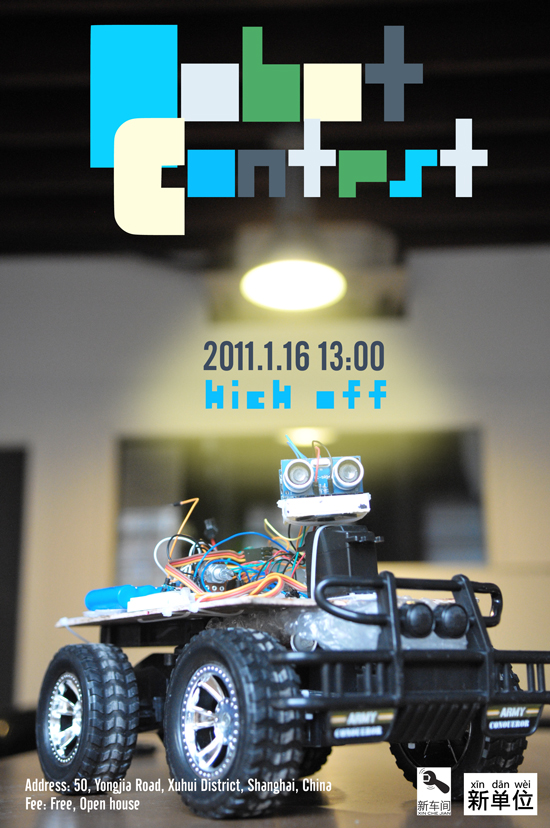 新车间开放日:休闲机器人的时代
时间: 2011年元月十六日,下午一点到五点
地点:徐汇区永嘉路50号新单位(近陕西南路)
费用: 免费
随着数字零件价格的降低加上丰富的开源机器人软件,DIY机器人已经可以当做事一个假日的休闲活动。这次的新车间开放日我们将介绍几个会员DIY的机器人和介绍一个将要举办的积极人竞赛。如果你对机器人有兴趣,请在这个周日加入我们,一起了解现代机器人的发展,一起讨论如何玩机器人。如果有小孩的话,非常欢迎他们一起来参加这个的活动。
– 关于HC Robot
http://code.google.com/p/hcrobot/
– 关于A.R.T.
http://xinchejian.com/?p=289
在这里注册
Robot Contest Kick Off- Xin Che Jian Open House: the coming of entertainment robots
Time: 13:00 – 17:00, Jan 16, 2011
Location: Xindanwei, 50 Yongjia Rd
Cost: Free, Open house
Building robots is fun and building robots to race is doubling the fun! The era of robot building as hobby has come and we plan to celebrate the beginning of this era with a festive robot contest. At this Xin Che Jian open house, we will present a few home built robots and the plan for a contest for discussion. Come and see how you can get involved! If you are a parent, bring the kids! We are sure they will love the robots!
Robots on site:
– HC Robot: open source home help robots
http://code.google.com/p/hcrobot/
– A.R.T.
http://xinchejian.com/?p=289
Register for the event here]]>
新车间开放日:休闲机器人的时代
时间: 2011年元月十六日,下午一点到五点
地点:徐汇区永嘉路50号新单位(近陕西南路)
费用: 免费
随着数字零件价格的降低加上丰富的开源机器人软件,DIY机器人已经可以当做事一个假日的休闲活动。这次的新车间开放日我们将介绍几个会员DIY的机器人和介绍一个将要举办的积极人竞赛。如果你对机器人有兴趣,请在这个周日加入我们,一起了解现代机器人的发展,一起讨论如何玩机器人。如果有小孩的话,非常欢迎他们一起来参加这个的活动。
– 关于HC Robot
http://code.google.com/p/hcrobot/
– 关于A.R.T.
http://xinchejian.com/?p=289
在这里注册
Robot Contest Kick Off- Xin Che Jian Open House: the coming of entertainment robots
Time: 13:00 – 17:00, Jan 16, 2011
Location: Xindanwei, 50 Yongjia Rd
Cost: Free, Open house
Building robots is fun and building robots to race is doubling the fun! The era of robot building as hobby has come and we plan to celebrate the beginning of this era with a festive robot contest. At this Xin Che Jian open house, we will present a few home built robots and the plan for a contest for discussion. Come and see how you can get involved! If you are a parent, bring the kids! We are sure they will love the robots!
Robots on site:
– HC Robot: open source home help robots
http://code.google.com/p/hcrobot/
– A.R.T.
http://xinchejian.com/?p=289
Register for the event here]]>
January 6th, 2011 § § permalink
December 26th, 2010 § § permalink
December 20th, 2010 § § permalink
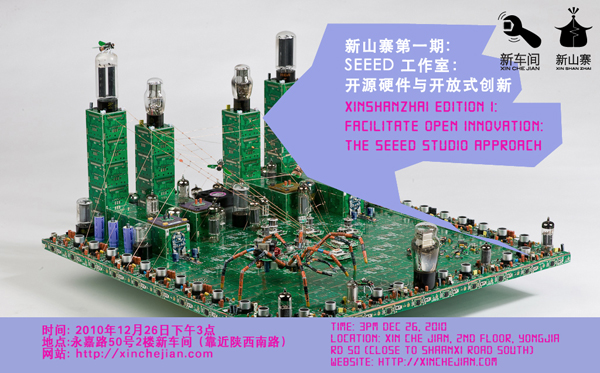 Time: 3pm Dec 26, 2010
Location: Xin Che Jian, 2nd floor, Yongjia Rd 50 (close to Shaanxi Road South)
Cost: 30RMB for non-Xinchejian members, free of charge for Xinchejian members.
Seeed Studio is an open hardware facilitation company based in Shenzhen, China. Benefiting from local manufacture power and convenient global logistic system, we integrate resources to serve new era of innovation. Seeed also works with global distributors and partners to push open hardware movement.
We design modular electronics for quick prototyping and small scale projects, which could be found at Bazaar. It also carries inventories from community innovators, we help people make, distribute their designs and collect the revenue. It’s a win-win situation and taking a shape towards an ecosystem. By working with us, innovators could focus on the designs, provide better support to the user and promote the product. Seeed Studio or similar service provider could get more traffic and bring up other product sales.
The manufacture part of hardware involves a lot details. We provide Propagate service to facilitate the process. Innovator send finished prototype with manufacturing files including Gerber file, BOM, test plan and other requirements. Our engineering team will validate and integrate the design into small batch production line. All products will be tested and packed under instruction. Innovators could also view current manufacture and distribution status from propagate. After deducting the manufacture costs, profit will be returned to innovators when inventory sold out.
To estimate the popularity before investing manufacture, innovators could post the idea or prototype to Wish. The community would vote, comment and collaborate on projects. You could also join interested groups to see what’s hot being worked on. By participating Wish, ideas with many votes could convert the popularity into coupons to purchase product or service. The idea poster could also share some coupon to the valuable commenter as appreciation.
Products and service info are hosted at a wiki called Garden. Feel free to add your guide, project or yourself as a freelancer.
About the speaker
Eric Pan, founder and director of Seeed Studio, grew up with DIY culture in China. He graduated as an EE bachelor from Chongqing University, with experiences and prizes from national wide contests of MCU, Embe dded Design, Robotics, and English skills. He first joined Intel in Chengdu as a FCBGA product Engineer whose main job includes quality control and new product integration. Then he worked at Beamstream LLC as international sourcing manager on system solutions. He established Seeed Studio since 2008 from bare ground and now turning it into an open source hardware facilitator with 30+ employee.
新山寨第一期: 开源硬件与开放式创新
时间:2010年12月26日下午3点
地点:徐汇区永嘉路50号2楼新车间 (靠近陕西南路)
费用:新车间会员免费, 非新车间会员每人30元
Seeed Studio 是一个位于深圳的开源硬件生产公司. 得益于本土制造业的巨大力量以及便利的全球物流系统. 我们整合不同资源从而服务于新纪元创新时代. Seeed也与全球分销商和合作伙伴合作共同推动开源硬件的前进.
Eric Pan 是Seeed studio 的创始人, 他从小受DIY文化影响. 他毕业于重庆大学,获得了电子工程学士学位. 他在微型计算机, 嵌入式设计, 机器人, 英文技能领域都有丰富经验集获奖. 他的第一份工作是在成都intel 担当FCBGA 产品工程师. 其主要工作是腹侧质量控制和新产品整合开发. 随后他在Beamstream LLC 工作担任国际采购经理. 在2008年他创立了Seeed studio —从零起点开始到现在拥有30名员工的开源硬件生产中心.
更多信息可以参考 http://seeedstudio.com/]]>
Time: 3pm Dec 26, 2010
Location: Xin Che Jian, 2nd floor, Yongjia Rd 50 (close to Shaanxi Road South)
Cost: 30RMB for non-Xinchejian members, free of charge for Xinchejian members.
Seeed Studio is an open hardware facilitation company based in Shenzhen, China. Benefiting from local manufacture power and convenient global logistic system, we integrate resources to serve new era of innovation. Seeed also works with global distributors and partners to push open hardware movement.
We design modular electronics for quick prototyping and small scale projects, which could be found at Bazaar. It also carries inventories from community innovators, we help people make, distribute their designs and collect the revenue. It’s a win-win situation and taking a shape towards an ecosystem. By working with us, innovators could focus on the designs, provide better support to the user and promote the product. Seeed Studio or similar service provider could get more traffic and bring up other product sales.
The manufacture part of hardware involves a lot details. We provide Propagate service to facilitate the process. Innovator send finished prototype with manufacturing files including Gerber file, BOM, test plan and other requirements. Our engineering team will validate and integrate the design into small batch production line. All products will be tested and packed under instruction. Innovators could also view current manufacture and distribution status from propagate. After deducting the manufacture costs, profit will be returned to innovators when inventory sold out.
To estimate the popularity before investing manufacture, innovators could post the idea or prototype to Wish. The community would vote, comment and collaborate on projects. You could also join interested groups to see what’s hot being worked on. By participating Wish, ideas with many votes could convert the popularity into coupons to purchase product or service. The idea poster could also share some coupon to the valuable commenter as appreciation.
Products and service info are hosted at a wiki called Garden. Feel free to add your guide, project or yourself as a freelancer.
About the speaker
Eric Pan, founder and director of Seeed Studio, grew up with DIY culture in China. He graduated as an EE bachelor from Chongqing University, with experiences and prizes from national wide contests of MCU, Embe dded Design, Robotics, and English skills. He first joined Intel in Chengdu as a FCBGA product Engineer whose main job includes quality control and new product integration. Then he worked at Beamstream LLC as international sourcing manager on system solutions. He established Seeed Studio since 2008 from bare ground and now turning it into an open source hardware facilitator with 30+ employee.
新山寨第一期: 开源硬件与开放式创新
时间:2010年12月26日下午3点
地点:徐汇区永嘉路50号2楼新车间 (靠近陕西南路)
费用:新车间会员免费, 非新车间会员每人30元
Seeed Studio 是一个位于深圳的开源硬件生产公司. 得益于本土制造业的巨大力量以及便利的全球物流系统. 我们整合不同资源从而服务于新纪元创新时代. Seeed也与全球分销商和合作伙伴合作共同推动开源硬件的前进.
Eric Pan 是Seeed studio 的创始人, 他从小受DIY文化影响. 他毕业于重庆大学,获得了电子工程学士学位. 他在微型计算机, 嵌入式设计, 机器人, 英文技能领域都有丰富经验集获奖. 他的第一份工作是在成都intel 担当FCBGA 产品工程师. 其主要工作是腹侧质量控制和新产品整合开发. 随后他在Beamstream LLC 工作担任国际采购经理. 在2008年他创立了Seeed studio —从零起点开始到现在拥有30名员工的开源硬件生产中心.
更多信息可以参考 http://seeedstudio.com/]]>
December 20th, 2010 § § permalink
Saw Ricky came in with a RC car today and kicked his Robot RC car project. Very cool! Read more…
Also, spoke NPI today about hosting robot RC car race in their place in the future. A robot F-1! That would be fun.]]>
 As I located the two H bridge on the board, I notice the RX-2 chip. Out of curiosity, I decide to google for this chip. To a pleasant surprise, I found
As I located the two H bridge on the board, I notice the RX-2 chip. Out of curiosity, I decide to google for this chip. To a pleasant surprise, I found 
 Decide to replace RX-2 in the car with Arduino so the H-Bridge on board can be reused and the RF for the remote can still work. Still trying to figure out what I am going to do with those remote control signal. A few facts about RX-2/TX-2 chip I found is that the RC frequency can be adjusted by different resistance from 100K to 500K Ohm between OSCI/OSCO pins.
Decide to replace RX-2 in the car with Arduino so the H-Bridge on board can be reused and the RF for the remote can still work. Still trying to figure out what I am going to do with those remote control signal. A few facts about RX-2/TX-2 chip I found is that the RC frequency can be adjusted by different resistance from 100K to 500K Ohm between OSCI/OSCO pins.
 ]]>
]]>  新车间开放日:休闲机器人的时代
时间: 2011年元月十六日,下午一点到五点
地点:徐汇区永嘉路50号新单位(近陕西南路)
费用: 免费
随着数字零件价格的降低加上丰富的开源机器人软件,DIY机器人已经可以当做事一个假日的休闲活动。这次的新车间开放日我们将介绍几个会员DIY的机器人和介绍一个将要举办的积极人竞赛。如果你对机器人有兴趣,请在这个周日加入我们,一起了解现代机器人的发展,一起讨论如何玩机器人。如果有小孩的话,非常欢迎他们一起来参加这个的活动。
– 关于HC Robot
http://code.google.com/p/hcrobot/
– 关于A.R.T.
http://xinchejian.com/?p=289
新车间开放日:休闲机器人的时代
时间: 2011年元月十六日,下午一点到五点
地点:徐汇区永嘉路50号新单位(近陕西南路)
费用: 免费
随着数字零件价格的降低加上丰富的开源机器人软件,DIY机器人已经可以当做事一个假日的休闲活动。这次的新车间开放日我们将介绍几个会员DIY的机器人和介绍一个将要举办的积极人竞赛。如果你对机器人有兴趣,请在这个周日加入我们,一起了解现代机器人的发展,一起讨论如何玩机器人。如果有小孩的话,非常欢迎他们一起来参加这个的活动。
– 关于HC Robot
http://code.google.com/p/hcrobot/
– 关于A.R.T.
http://xinchejian.com/?p=289
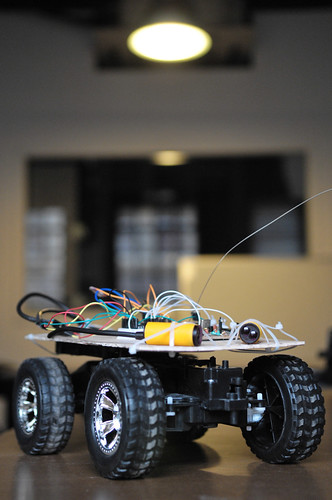
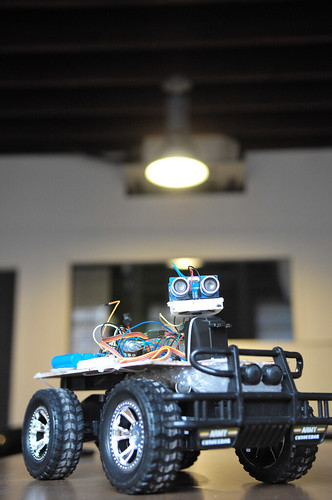
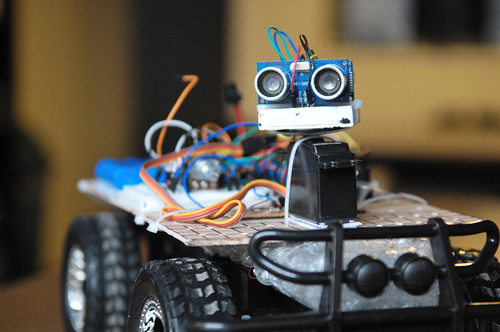
 Seeed Studio was founded 3 years ago in Shenzhen to explore combining open source hardware and the electronics supply chain in Shenzhen. Today, Seeed Studio employes over 30 engineers and support staffs with over USD$1 million in annual revenue mainly from US, Europe and Japanese customers which are 98% of its business. Seeed does not yet focus on Chinese market as Eric points out that the tinkers/makers community in China has not yet matured enough for Seeed and there is not enough community.
Seeed Studio has so far depends on words of mouth of open hardware community for its marketing and will launch its first marketing campaign in 2011. The following is one of the first ads to be run in
Seeed Studio was founded 3 years ago in Shenzhen to explore combining open source hardware and the electronics supply chain in Shenzhen. Today, Seeed Studio employes over 30 engineers and support staffs with over USD$1 million in annual revenue mainly from US, Europe and Japanese customers which are 98% of its business. Seeed does not yet focus on Chinese market as Eric points out that the tinkers/makers community in China has not yet matured enough for Seeed and there is not enough community.
Seeed Studio has so far depends on words of mouth of open hardware community for its marketing and will launch its first marketing campaign in 2011. The following is one of the first ads to be run in  Seeed’s current focus is to grow its
Seeed’s current focus is to grow its  Eric’s 30 minutes talk was followed by over 2 hours of heated discussion on the topics of open source hardware, innovation and manufacture. The talk and discussions were livecast on Sina Weibo by
Eric’s 30 minutes talk was followed by over 2 hours of heated discussion on the topics of open source hardware, innovation and manufacture. The talk and discussions were livecast on Sina Weibo by  Time: 3pm Dec 26, 2010
Location: Xin Che Jian, 2nd floor, Yongjia Rd 50 (close to Shaanxi Road South)
Cost: 30RMB for non-Xinchejian members, free of charge for Xinchejian members.
Time: 3pm Dec 26, 2010
Location: Xin Che Jian, 2nd floor, Yongjia Rd 50 (close to Shaanxi Road South)
Cost: 30RMB for non-Xinchejian members, free of charge for Xinchejian members.